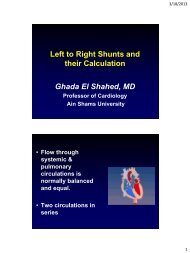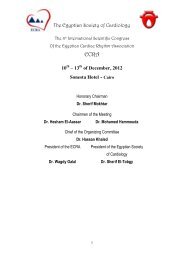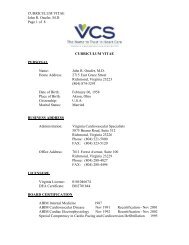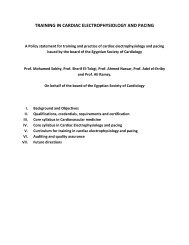the egyptian society of cardiology board of ... - Cardioegypt.com
the egyptian society of cardiology board of ... - Cardioegypt.com
the egyptian society of cardiology board of ... - Cardioegypt.com
Create successful ePaper yourself
Turn your PDF publications into a flip-book with our unique Google optimized e-Paper software.
Egypt Heart J 62 (1): 39-52, March 2010<br />
Metabolic Syndrome and its Impact on Vascular Damage Extent<br />
AYMAN SADEK, MD; MAGDY NOUH AIN, MD; HANY FOUAD HANAA, MD;<br />
RAMZY HAMED EL-MAWARDY, MD<br />
Background: Metabolic syndrome is associated with increased risk <strong>of</strong> cardiovascular diseases in patients without a<br />
cardiovascular history, <strong>the</strong>re is nearly 3 fold increase cardiovascular related mortality <strong>com</strong>pared to subjects without metabolic<br />
syndrome.<br />
Aim <strong>of</strong> <strong>the</strong> Work: Was to investigate <strong>the</strong> relation between metabolic syndrome and extent <strong>of</strong> vascular damage.<br />
Methods and Results: We conducted a prospective observational study <strong>of</strong> 50 patients with history <strong>of</strong> coronary artery disease,<br />
history <strong>of</strong> stroke TIA or Peripheral arterial disease between January 2005 and March 2006 at Ain Shams University hospitals,<br />
Egypt. Patients having criteria <strong>of</strong> metabolic syndrome were identified. Echocardiography, carotid and femoral duplex, detection<br />
<strong>of</strong> microalbuminuria were done for <strong>the</strong> study population The study population was divided into three groups: Group I included<br />
12 patients with 3 metabolic risk factors, group II included 17 patients with 4 metabolic risk factors and group III included 21<br />
patients with 5 metabolic risk factors. Comparison between <strong>the</strong> study groups as regard intima media thickness (IMT) <strong>of</strong> <strong>the</strong><br />
carotid and femoral arteries revealed that right carotid IMT was 0.97mm ±0.17, 1.13mm ±0.14 and 1.18mm ±0.17 in group I,II<br />
and III respectively (p=0.002). Left carotid IMT was 0.97mm ±.19, 1.12mm ±0.12 and 1.19mm ±0.19 in group I,II and III<br />
respectively [p=0.003 right femoral IMT was 0.98 mm ±0.23, 1.11mm ± 0.18 and 1.09 mm ±0.20 in group I,II and III respectively<br />
(p=078)] left femoral IMT was 0.90mm ±.23, 1.10mm ±0.09 and 1.08 mm ±0.15 in group I,II and III respectively (p=0.003).<br />
Comparison between <strong>the</strong> study groups as regard presence <strong>of</strong> carotid or femoral plaques revealed that presence <strong>of</strong> carotid plaque<br />
was positive in 0.0 patient (0%) <strong>of</strong> group I and 5 patients (29.4%) <strong>of</strong> group II and 12 patient (57.1%) <strong>of</strong> group III (p=0.023).<br />
Presence <strong>of</strong> femoral plaque was positive in 3 patients (25%) <strong>of</strong> group I and 4 patients (23.5%) <strong>of</strong> group II and 8 patient (38.1%)<br />
<strong>of</strong> group III (p=0.56). Microalbuminuria was positive in 1 patient (8.3%) in group I, 4 patients (23.5%) <strong>of</strong> group II and 11<br />
patients (52.4%) <strong>of</strong> group III (p=0.022). When <strong>com</strong>paring between <strong>the</strong> study groups as regard number <strong>of</strong> vascular beds affected<br />
in each group (coronary, cerebral and peripheral vascular beds), we found that group I 10 patients (40%) was having one vascular<br />
bed affected, 2 patients (8.7%) having two vascular beds affected and 0.0 patient (0%) having three vascular beds affected, in<br />
group II we found that 10 patients 40% was having one vascular beds affected 7 patients (30.4%) having two vascular beds<br />
affected and 0.0 (0%) patient having three vascular beds affected. In group III we found that 5 patients (20%) was having one<br />
vascular beds affected 14 patients (60.5%) having two vascular beds affected and 2 (100%) patients having three vascular beds<br />
affected. Right femoral IMT was 1.06±0.19mm when one vascular bed affected, 1.13±0.22mm when two vascular beds affected<br />
and 1.12±0.17mm when three vascular beds affected (p=0.59). Left femoral IMT was 0.9±0.22mm when one vascular bed<br />
affected, 1.09±0.22mm when two vascular beds affected and 1.09±0.15mm when three vascular beds affected (p=0.003)<br />
Comparison between <strong>the</strong> presence <strong>of</strong> positive microalbuminuria and number <strong>of</strong> vascular beds affected revealed that it was<br />
positive in 2 patients (8.0%) when one vascular bed affected, 12 patients (52.2%) when two vascular beds affected and 2 patients<br />
(100%) when three vascular beds affected (p=0.001).<br />
Conclusions: Metabolic syndrome is constellation <strong>of</strong> risk factors for a<strong>the</strong>rosclerosis and increase in traits <strong>of</strong> metabolic<br />
syndrome is associated with increase in extent <strong>of</strong> vascular damage. The increase in traits <strong>of</strong> metabolic syndrome is associated<br />
with increase in carotid and femoral IMT and presence <strong>of</strong> microalbuminuria. The presence <strong>of</strong> thickened carotid and femoral<br />
IMT and presence <strong>of</strong> microalbuminuria is associated with increase in extent <strong>of</strong> vascular damage.<br />
Key Words: Metabolic syndrome – Vascular damage.<br />
Faculty <strong>of</strong> Medicine, Ain Shams University.<br />
Manuscript received 10 Sep., 2009; revised 20 Oct., 2009;<br />
accepted 21 Oct., 2009.<br />
Address for Correspondence: Dr. Ayman Sadek, Faculty <strong>of</strong><br />
Medicine, Ain Shams University.<br />
39








